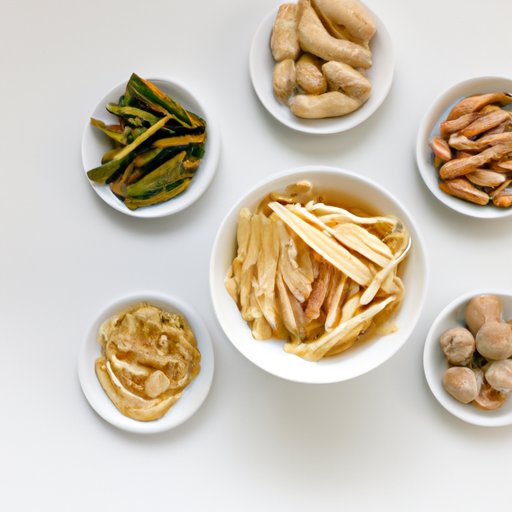Introduction
Gluten intolerance and allergies are becoming more and more common. With this increase in awareness comes a greater need for information on how to cut gluten out of your diet. Gluten is a protein found in wheat, rye, and barley that causes an immune reaction in people with celiac disease or non-celiac gluten sensitivity. Going gluten-free can help alleviate symptoms and improve overall health. This article will provide tips, recipes, and benefits of a gluten-free diet.
A Beginner’s Guide to Going Gluten-Free: Tips and Tricks
Understanding sources of gluten is important when starting a gluten-free diet. Common sources of gluten include bread, pasta, cereals, and beer. It’s also important to know that gluten can be found in unexpected places such as soy sauce, salad dressings, and even some medications.
Reading food labels can be overwhelming but is essential when starting out on a gluten-free diet. Look for foods that are labeled gluten-free or made with gluten-free ingredients. Be wary of cross-contamination, which can occur when gluten-free products come into contact with gluten-containing products during production or preparation.
There are plenty of gluten-free alternatives for common foods. For example, quinoa can be used as a substitute for couscous or pasta, and zucchini noodles can replace spaghetti. There are also many gluten-free bread and pasta options available at health food stores and online retailers.
Dining out can be a challenge when on a gluten-free diet. It’s best to call ahead and research restaurants that offer gluten-free options. Avoid fried foods or dishes with breaded or battered ingredients. Look for restaurants that use separate cooking utensils and pans to prevent cross-contamination.
Gluten-Free Without Losing Flavor: Delicious Recipes and Substitutions
Gluten-free grains and flours can be used in place of wheat flour. Some popular gluten-free flours include almond flour, coconut flour, and rice flour. Experiment with different gluten-free ingredients to find what works best for you.
There are many delicious recipes that are naturally gluten-free. For breakfast, try a spinach and feta omelet or gluten-free banana pancakes. For lunch, a kale and quinoa salad or turkey and avocado wrap on a gluten-free tortilla is a great option. For dinner, try gluten-free spaghetti with marinara sauce or grilled chicken with a side of roasted vegetables.
Substitutions for gluten-containing ingredients can also be made when cooking at home. Use gluten-free breadcrumbs in meatloaf or use corn tortillas instead of flour tortillas in tacos.
The Dos and Don’ts of a Gluten-Free Lifestyle
When starting a gluten-free diet, it’s important to know what to eat and what to avoid. Foods to eat on a gluten-free diet include fruits, vegetables, lean proteins, and gluten-free grains such as quinoa and brown rice. Foods to avoid include wheat, rye, and barley, as well as any products made with these grains.
Meal planning and preparation can make sticking to a gluten-free diet easier. Plan meals ahead of time and always have gluten-free snacks on hand for when hunger strikes. Cook meals in bulk and freeze leftovers for quick and easy meals during the week.
Sticking to a gluten-free diet isn’t always easy, but it’s important for long-term health. Remember to always read food labels and ask questions when dining out.
Foods You Didn’t Know Contain Gluten: A Comprehensive List
There are many surprising sources of gluten that can be easily overlooked. Some unexpected sources of gluten include soy sauce, gravy, and some instant coffee brands. Always read food labels carefully and look for hidden sources of gluten.
Strategies for avoiding gluten in unexpected places include asking questions when dining out, bringing gluten-free snacks when traveling, and doing research ahead of time to find gluten-free options in unfamiliar settings.
How to Handle Social Situations While on a Gluten-Free Diet
Explaining your dietary restrictions to others can be challenging. It’s important to educate those around you on your dietary needs and communicate any potential health concerns. Bring your own gluten-free dish to gatherings or offer to help make a gluten-free meal for everyone to enjoy.
Navigating parties and gatherings can be difficult when on a gluten-free diet. Plan ahead by bringing your own gluten-free snacks and researching the menu ahead of time to find gluten-free options. Don’t be afraid to ask your host if there will be gluten-free options available.
Traveling while gluten-free is possible with a little extra preparation. Research gluten-free options at your destination and bring plenty of gluten-free snacks for the journey. Call ahead to your hotel or rental property to ensure there will be gluten-free options available.
The Benefits of Going Gluten-Free for Your Health and Well-Being
Going gluten-free can have many positive health effects. For people with celiac disease or gluten sensitivity, it can alleviate symptoms such as stomach pain and bloating. It can also improve overall gut health and nutrient absorption.
Gluten-free diets may also have benefits for people with other health conditions such as autoimmune disorders and autism spectrum disorders. Speak with a healthcare professional before starting a gluten-free diet to ensure it’s the right choice for you.
Conclusion
Going gluten-free can be overwhelming, but with the right tools and strategies, it’s manageable and can lead to improved health and well-being. Remember to read food labels, plan ahead, and communicate your dietary needs to those around you. With the delicious recipes and alternatives available, going gluten-free doesn’t have to mean sacrificing flavor and enjoyment in your meals.
Remember that a gluten-free lifestyle takes time and patience, but the benefits are worth it. Consult with a healthcare professional if you’re considering a gluten-free diet.
(Note: Is this article not meeting your expectations? Do you have knowledge or insights to share? Unlock new opportunities and expand your reach by joining our authors team. Click Registration to join us and share your expertise with our readers.)
